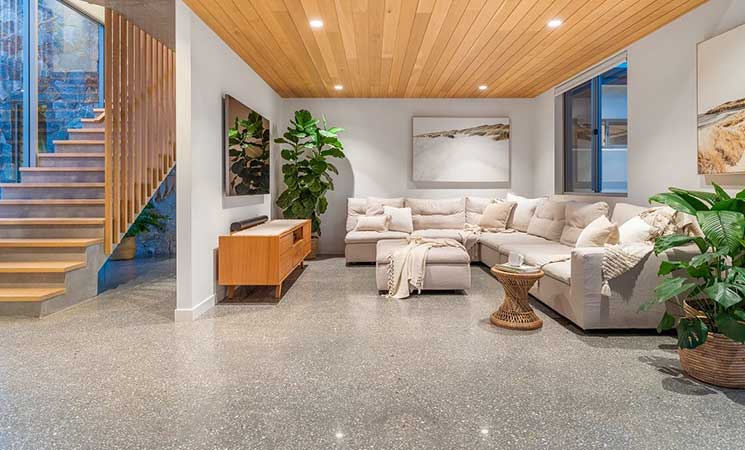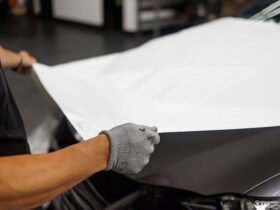Polished concrete has become a popular flooring option in recent years, thanks to its sleek appearance and exceptional functionality. Unlike traditional concrete, polished concrete undergoes a process that transforms its surface into a smooth, reflective, and durable finish. This transformation not only enhances the aesthetic appeal but also improves the floor’s performance in terms of durability and maintenance.
Importance of Durable and Clean Flooring Solutions
Durable and clean flooring solutions are essential for maintaining a healthy and attractive environment, whether in homes, commercial spaces, or industrial settings. Flooring that withstands heavy use without deteriorating or accumulating dust contributes significantly to the overall cleanliness and functionality of a space. This is where polished concrete excels, offering a solution that meets the demands of both durability and cleanliness.
What is Concrete Polishing?
Concrete polishing is a multi-step process that involves grinding, honing, and polishing a concrete surface to achieve a desired level of smoothness and shine. The process enhances the concrete’s natural beauty while significantly improving its structural integrity and ease of maintenance.
Process of Polishing Concrete Floors
Surface Preparation: The first step involves cleaning the concrete surface to remove any debris, grease, or existing coatings. This preparation is crucial for achieving a smooth and even finish.
Grinding: Heavy-duty grinders with diamond-embedded discs are used to grind down the concrete to the desired level of smoothness. This step removes any imperfections and opens up the concrete’s pores.
Honing: After grinding, the surface is honed using finer diamond abrasives. This step further smooths the concrete and begins to develop its sheen.
Polishing: The final step involves polishing the surface with increasingly finer grits until the desired level of shine is achieved. A densifier is often applied to harden the concrete and enhance its durability.
Sealing: A sealer may be applied to protect the polished surface from stains and spills, making it easier to maintain.
How Polished Concrete Strengthens Flooring
Polished concrete is renowned for its enhanced durability. The polishing process densifies the concrete, making it significantly harder and more resistant to wear and tear. The application of a densifier penetrates the concrete surface, filling in the pores and increasing the material’s density and strength. This process results in a floor that can withstand heavy foot traffic and resist damage from impacts, scratches, and spills.
Comparison with Other Flooring Options
Compared to other flooring options like carpet, tile, or vinyl, polished concrete stands out for its durability. Carpets can wear down and stain easily, while tiles can crack and require frequent grout maintenance. Vinyl floors may peel or become damaged over time. In contrast, polished concrete floors maintain their integrity and appearance for decades with minimal maintenance, offering a cost-effective and long-lasting flooring solution.
Examples of Environments Where Durability is Crucial
Polished concrete is ideal for various environments where durability is paramount. In homes, polished concrete is perfect for high-traffic areas like kitchens, hallways, and living rooms. In commercial spaces such as retail stores, offices, and restaurants, it provides a durable surface that can handle constant foot traffic. Industrial settings like warehouses and factories also benefit from polished concrete’s ability to withstand heavy machinery and equipment without deteriorating.
How Unpolished Concrete Contributes to Dust
Unpolished concrete surfaces are porous and rough, which means they continuously shed tiny particles. This dusting occurs as the concrete surface wears down and produces fine dust particles that settle on floors, fixtures, and in the air. This dust can be particularly problematic in environments that prioritize cleanliness and air quality.
The Impact of Dust on Health and Maintenance
Excessive dust can negatively impact both health and maintenance efforts. In homes and workplaces, dust can exacerbate allergies and respiratory conditions, reducing indoor air quality. For businesses, maintaining a dust-free environment is crucial to protecting products, machinery, and the well-being of employees. Frequent cleaning to manage dust can also increase maintenance costs and labor.
How Polished Concrete Reduces Dust Production
Polished concrete significantly reduces dust production by creating a smooth, sealed surface that resists wear and prevents the release of dust particles. The polishing process hardens the concrete and closes off its pores, minimizing the surface’s ability to produce dust. As a result, polished concrete floors contribute to a cleaner, healthier environment with less need for frequent cleaning and maintenance.
Ease of Cleaning Polished Concrete Floors
One of the standout benefits of polished concrete floors is their ease of cleaning. Thanks to their smooth, sealed surface, polished concrete floors resist staining and dirt accumulation. Everyday maintenance typically involves simple tasks such as sweeping or vacuuming to remove dust and debris, followed by damp mopping with a pH-neutral cleaner. This straightforward cleaning routine keeps the floors looking pristine without the need for specialized equipment or harsh chemicals.
Long-Term Maintenance Compared to Other Flooring Types
Compared to other flooring types, polished concrete requires significantly less long-term maintenance. Carpet, for instance, needs regular vacuuming, deep cleaning, and eventual replacement due to wear and tear. Tile floors require frequent grout cleaning and can crack or chip, necessitating repairs. Vinyl and laminate floors can suffer from peeling and damage over time, often needing replacement. In contrast, polished concrete floors are highly durable and maintain their appearance with minimal effort. Periodic resealing might be necessary to maintain their shine, but overall, the maintenance demands are lower, saving time and money in the long run.
Recommended Cleaning Practices for Polished Concrete
To keep polished concrete floors in top condition, it’s important to follow recommended cleaning practices:
- Daily Cleaning: Sweep or vacuum to remove loose dirt and debris that could scratch the surface.
- Weekly Cleaning: Damp mop with a pH-neutral cleaner to remove any lingering dirt or spills. Avoid using harsh chemicals or acidic cleaners, as they can damage the finish.
- Periodic Maintenance: Depending on the level of foot traffic, consider resealing the floor every few years to maintain its protective layer and shine.
- Spill Management: Wipe up spills promptly to prevent staining, even though polished concrete is more resistant to stains than unpolished surfaces.
Environmental and Health Benefits
Improved Indoor Air Quality with Polished Concrete
Polished concrete floors contribute to improved indoor air quality by reducing dust and allergen accumulation. Unlike carpet, which can trap dust, pet dander, and other allergens, polished concrete provides a hypoallergenic surface that is easy to clean. The smooth, sealed finish prevents dust particles from becoming airborne, creating a healthier living environment. This makes polished concrete an excellent choice for homes, offices, and public buildings where air quality is a priority.
Benefits for Allergy Sufferers and Environments Requiring Cleanliness
For allergy sufferers, polished concrete floors offer a significant health benefit. The reduced dust and allergen accumulation can alleviate symptoms and contribute to overall well-being. In environments that require strict cleanliness, such as hospitals and kitchens, polished concrete is particularly advantageous. Its non-porous surface resists bacteria and mold growth, making it easier to maintain a sanitary space. The ease of cleaning and resistance to contaminants help ensure that these critical areas remain hygienic.
Long-Term Cost Savings of Durable, Low-Maintenance Floors
Polished concrete floors offer substantial long-term cost savings due to their durability and low maintenance requirements. Unlike other flooring options that may need frequent replacements or repairs, polished concrete can last for decades with minimal upkeep. This longevity reduces the need for costly flooring renovations, making it a financially smart choice for both residential and commercial properties.
Reduced Need for Cleaning Supplies and Labor
The ease of maintaining polished concrete floors translates to lower costs for cleaning supplies and labor. Since these floors do not require waxing, stripping, or frequent deep cleaning, the expenses associated with maintaining them are significantly reduced. This cost-efficiency benefits homeowners and businesses alike, freeing up resources for other essential areas.
Conclusion
Polished concrete floors offer numerous benefits, making them an excellent choice for various settings. They enhance durability and reduce dust, contributing to cleaner and healthier environments. The ease of maintenance and long-term cost savings further solidify their appeal. Whether in homes, commercial spaces, or industrial settings, polished concrete provides a durable, attractive, and cost-effective flooring solution. By choosing polished concrete, property owners can enjoy a beautiful, low-maintenance floor that stands the test of time, offering both functional and aesthetic advantages. Consider this versatile option for your next flooring project and experience the benefits firsthand.












